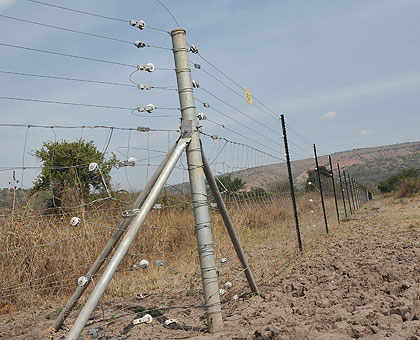The Rwanda Development Board (RDB) has inaugurated an electric fence around Akagera National Park meant to reduce human-wildlife conflict in the area.


The Rwanda Development Board (RDB) has inaugurated an electric fence around Akagera National Park meant to reduce human-wildlife conflict in the area.The inauguration ceremony took place in Nyamwashama village, Mwiri Sector in Kayonza District on Thursday.The fence is supposed to bring to an end life, crop and livestock loss due to straying animals from the park.Officials also hope it will also end poaching that has led to loss of certain animal species."This is a celebration for all park residents ...we had the problem of animals that destroyed our plantations causing persistent hunger in our area; now that we have the fence we hope they won’t again disturb us,” Claudette Nyirahabineza, a resident of Mwiri said.Athanase Ndahimana, a farmer recounted spending sleepless nights using several tactics to guard against his crop raids every season.These include drumming to hound away the animals from their gardens which Ndahimana said could not scare away some dangerous animals.The cheerful farmers believe the fence will lower crop and livestock loss which has previously led to food shortages in the districts neighbouring the park.Some of the species that had terrorised the communities include buffaloes, elephants, hippos, wild pigs and baboons.The most affected sectors were Rwemiyaga, Karangazi, Ndego, Mwiri.The project was funded by Rwanda Development Board at the tune of over Rwf 2.7 billion and it is expected to last 40 years. Covering 110 kilometers, the fence has 1.8m highline of metallic posts with 8 horizontal electrified wires.The posts support a 1m high mesh to allow higher resistance to passage of small animals like rodents. The fence is powered with solar energy a resource abundant in the area with power energisers.Addressing the residents, John Mugabo, the Mayor of Kayonza District, warned against tampering with the electric fence."These animals killed some people, destroyed property and at the same time some of you killed them. However, you will now live harmoniously and look at them as important for our economy. You should, however, prevent your children from getting closer to this fence,” he said.The park, with six lakes including Ihema, Kivumba, Hago Kisanju, Mihindi and Rwanyakizinga, is among the country’s major tourist destinations.Currently, tourism is Rwanda’s top foreign exchange earner. Last year, the sector generated about Rwf178 billion. RDB says the sector has recorded investments worth $32.8 million this year.Clare Akamanzi, the RDB acting CEO, observed that the construction of the fence was in line with government’s strategy to reduce human-wildlife conflict. "We will continue working together with all the responsible authorities to ensure that the fence is secure and protected for the continued benefit of tourism sector,” she said.Musa Fazil Harelimana, the Internal security minister, advised responsible parties to plant trees around the fence and cautioned residents against illegal entry into the park.The park covers over 2,500 square kilometres of savannah west of the Kagera River, which denotes the frontier with Tanzania.It has a variety of wildlife and is a habitat for over 500 different species of birds.It was founded in 1934 to protect animals and vegetation in three eco-regions: savannah, mountain and swamp. The park is named after the Kagera River which flows along its eastern boundary feeding into several lakes the largest of which is Lake Ihema. In 2009, RDB and the African Parks Network entered into a 20-year agreement for the joint management of the park. The Akagera Management Company was formed in 2010 as the joint management body for Akagera National Park.


